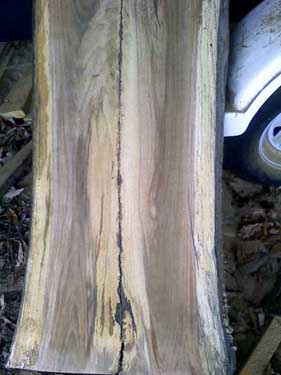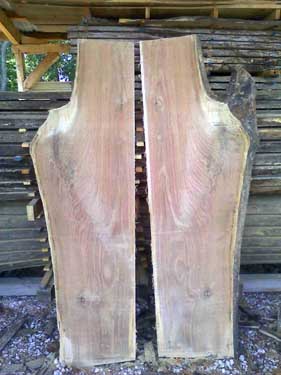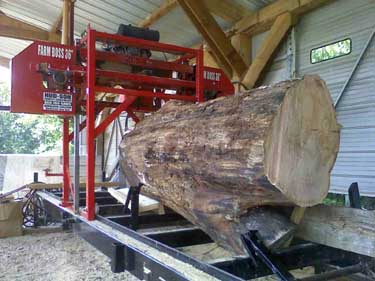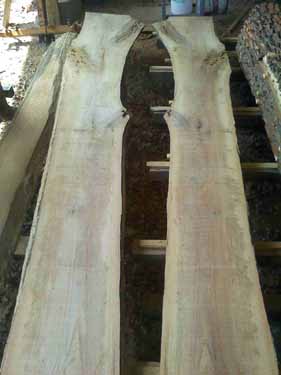How soon after a tree has fallen should it be cut into slabs? Is a year too long to wait?
From contributor Ke
Any wood species in my area would have insects under the bark, and in the sapwood after that long. And if they are low on decay and insect resistance, through the whole log.
You ought to give a location and wood species to get the best advice.
From contributor Ge
A living tree that is cut down should normally be sawn within a month for best color and quality. The white woods need to go faster, especially in warm weather. Same with pine.
A tree that blows down likely has some issues (that is why is blew down) and so prompt sawing would minimize additional degradation.
It is hard to be more specific without more info.
From contributor Br
The tree in question was a Red Oak which blew down 9 months ago in NW GA. Will it be worth harvesting after that long? If it has insects is there a way to deal with that and salvage the lumber?
From contributor Te
IF your cutting slabs the more defect the more desirable, IF cutting furniture grade as in qtr sawn it'll be border line but plain/flat sawn will probably show some streaking by now. Doc can tell you more on the premium clean grade affects.....I saw for UGLY!!! LOL the longer it sets, the UGLIER it gets!!!
You did say slabs....check out my website there should be some oaks there.
Have a Blessed evening in Jesus's Awesome Love.
From contributor Te
Here's a few pics that aren't on the site yet. As you can see I don't let aging effect my cutting. One that is a full spalt I actually found in the woods and most barkwood and 1st layer was done gone guessing down over 3 yrs. Another maybe 9-12 months on log yard prior to cutting.
#1 thing to remember...SEAL the log ends ASAP after cutting to log length!!!


From contributor Ge
Good pictures TT.
For someone who is newer, here is what I see. The top picture, appears to be walnut with the white sapwood full of white rot. Note the long dark lines running vertically in the white sapwood and the bleached-yellowish appearance. These indicate white rot. White rot grows slowly, so this log or tree died probably two years or so before sawing into lumber.
In the second picture (looks like cherry), the branch near the top must have died and a little decay (or rot) came into the main stem, but the tree resisted this intrusion by encapsulating the region. Trees do not have antibodies like we do, so they encapsulate, or at least try. The branch must have formed early in the tree's life as the grain is swirly in a long region.
In the third picture, note that TT has the dogs in position to hold the log securely, even though one might believe gravity could do well by itself...dogs are always to be used.
So, Tennessee Tim, did I get this close to correct?
From contributor Te
WEEEELLLL......Gene you got me researching through many files and threads and I still came up with the same IF I didn't document under a wrong file name. The day I sawed the first pic I also posted a thread and for some reason I've only found that one pic BUT It's an oak ???? according to my documents....BUT I will search deeper now to verify. I did find the pic I meant to post though (posting) and it's definitely dead oak.
The second is red oak that was growing (as the one I'm posting) next to some power lines and supposedly they had cut the dead section away 2-3 yrs before and left laying. The fresh one was close enough that they had probably pruned the limb several years ago prior to cutting the main trunk. BOTH came off the same stump/crotch/ sprouts from an old!!!! base. AND I think pic #1 is the base section????
Third pic....Yeeeeaaap your right ...It's all about safely dogging.
Your info is on track....me letting logs age causes color shifts and no bark to go by does make the identifying harder to guess.
Thanks and have a Blessed day in Jesus's Awesome Love,
From contributor Br
Thanks, Tennessee Tim. I do plan on cutting slabs with which to make tables, benches, etc. So when older wood is cut and dried, does any rot stop. Also, if it has pests, what do you do about those? I do not have access to a kiln and therefore plan to air dry.
From contributor Te
Stop rot???? I don't have the technical answers......BUT in my opinion when the moisture is removed it kills the fungus/bacteria ( which ever it is) from activating any further then what stage it's at WHEN that moisture level is achieved.
Pests and insects .....I garauntee after being fallen for 9 months in hot Georgia the critters have done made a home. I attempt to air dry for a year per inch thickness sawn THEN kiln dry to pull MC from 14% down to 6-8% then heat/sterilize to above 130 deg for 48 hrs + to kill creepy crawlys. Search the above right column "find a Kiln Dryer" for the last stage.
This is not how everyone does it....JUST MY opinion of correct. Enjoy and PLEASE post pictures of tree, sawing, boards and in the future finished project. We as sawyers LOVE to see the final products!!!!
Have a Blessed evening in Jesus's Awesome Love,
Tim
From contributor Ge
What fooled me on the first picture was the amount of sapwood. But I guess the Southern oaks do indeed have much more sapwood than what I see up here or what is in the second picture.
A good point is that the sapwood is the first to go, while the heartwood often is able to resist deterioration for a longer time...some species for ten years or more.
From contributor Da
You'll find out whether it was worth harvesting after you've put the saw into it. As long as you have the equipment to do it safely, go for it. You'll know whether it is solid when you cut it to length, but even then, there will be surprised. I've cut logs that appeared to be sound, but were full of ants, and others that looked rotten, but yielded beautiful lumber. TT is exactly right. As long as you or your customer see "character" instead of "defect", it will be worth checking out. Worst case scenario-- you've got a little more firewood.
How do you plan to mill the slabs?
Here's a link to a post showing my experience with blown-down walnut-- at least 8 years on the ground.
From contributor Br
Dave,
I am actually considering purchasing an Alaskan chain saw mill. The Red oak is in my back yard and I always told myself if it fell I wanted to harvest the slabs.
I have a good friend who is an arborist and tree surgeon. He will connect me with other fallen trees so that I can begin drying a variety of slabs.
Hope to begin purchasing a few small slabs to see if I have the ability to build live edge furniture.
From contributor Da
Bruce, I bet you have the ability. Patience is another matter. That's why I run a sawmill and leave the details of building with it to others! Best of luck. Hope to see photos of your progress.
From contributor JS
TT do you have an air drying facility that keeps weather off your slabs while they dry or do you keep them outdoors and let them weather dry and get more "character"? Enjoyed your website, how are your sales going there on the live slabs as well as projects you're putting together?
From contributor Te
I do my AD under a roof shelter. Thanks for visiting my website and glad you enjoyed...sales are slowly rising as I'm a new start-up business and getting my name built up in a specialty market, thanks for asking. I'm getting to see the Lord Bless me with more inventory AND the patience to wait as it builds it's character before sawing and the endurance to watch it dry SLOWLY.
From contributor Da
TT, I always enjoy your perspective on things. I learn a lot from your posts. Best wishes for your business! Let me know if you're ever in southwest MO.
From contributor Br
TT, how far are you from Cleveland, TN? I most travel there after the holidays and would love to come by...
From contributor Te
Bruce, ???? to Cleveland...BUT I'm 50 miles east on I-40 from Nashville. Just a hop (5 miles)off interstate. Send me a private message and I'll get you more info or visit website and get my contacts there.
From contributor wo
The heart wood will be fine, but the sapwood will be to trim away after being on the ground for several months. I'm still sawing red oak and white oaks blown down by Katrina. The sap has rotted away but the heart yields some really good wood